Turing Phone Dark Wyvern Edition Review
Turing Phone Dark Wyvern Edition Review
Hands-on: You'll never hack this phone. But will you want to use it?
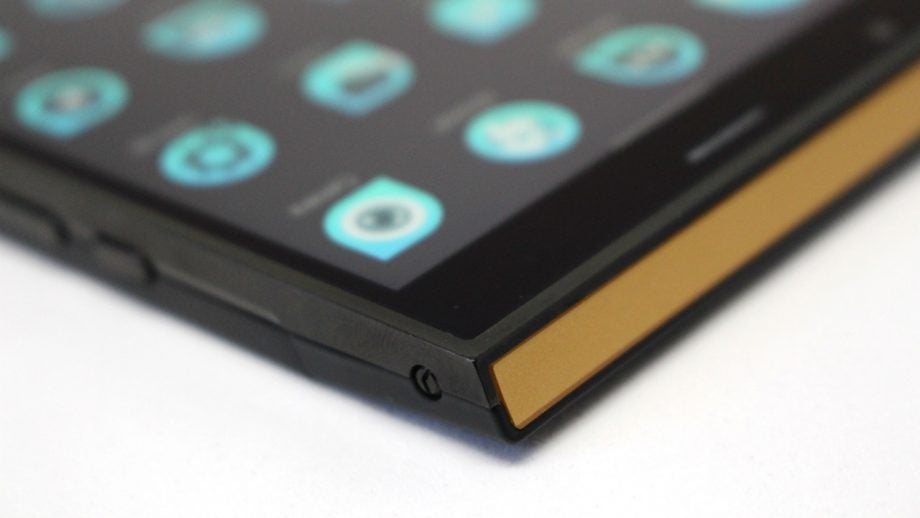
Verdict
Pros
Cons
Key Specifications
- Sailfish 2.0
- Qualcomm Snapdragon 820
- 151.8 x 77.1 x 9mm
- 5.5-inch screen
- Fingerprint scanner
- Wallaby MagStream port
- 3GB RAM
- 13-megapixel rear-facing camera
- 128GB storage
- 3,000mAh battery
Hands On: Turing Phone Dark Wyvern Edition
To say the Turing Phone is unique would be an understatement. The first product from the boldly named Turing Robotic Industries, it was announced last year in a blaze of publicity, and at the time was claimed to be hacker-resistant and practically indestructible thanks to its “liquid morphium” construction.
Related: Best Android phones

Pre-orders opened and plenty of people laid down their money in the expectation that they’d have this innovative Android device in their hands by the end of the year, but that didn’t come to pass. Android was ditched in favour of the more secure – but less well-known – Sailfish OS from Finnish firm Jolla, and a series of delays pushed the release into 2016.
At the time of writing, the “final” device still isn’t out. Instead, buyers are being sent “evaluation” units that lack the promised waterproof coating and boast a very basic, untouched version of Sailfish 2.0, without Turing’s much-hyped “Imitation Key” end-to-end encryption system enabled.
The downside for the consumers who have stuck with the company thus far is effectively having to make do with an unfinished prototype of the phone they paid hundreds of pounds for last year. On the upside, these units are being provided free of charge, and the final phone – expected at the end of 2016 – will pack a faster Qualcomm Snapdragon 820 processor. Those two points should certainly help soften the blow.
Related: Best budget phones
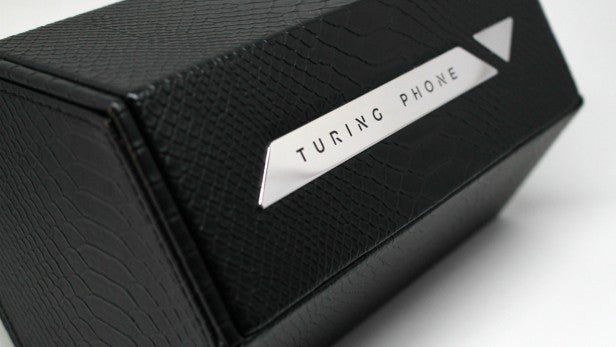
One of the big selling points of the Turing Phone is the fact that it’s constructed from an extremely tough “liquid metal” material which, it’s claimed, is stronger than titanium and incredibly scratch-resistant.
Footage of a high-pressure bend test appears to support this stance, and when taking the phone out of its stunningly lavish box, the first thing that struck me was the sheer weight of it; this device has some serious heft to it. With dimensions of 151.8 x 77.1 x 9mm, it’s quite a large handset, but the fact that the 5.5-inch screen has very thin bezels means that it isn’t as enormous as some of its rivals.
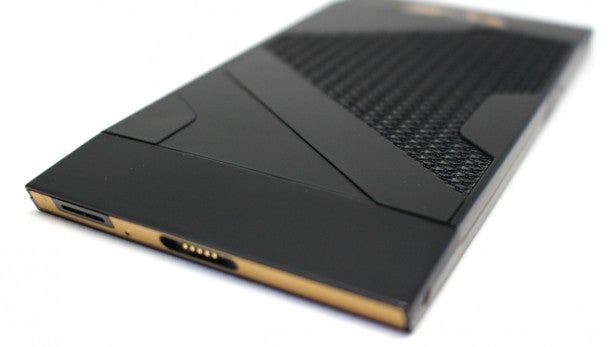
The design of the Turing Phone is sure to turn heads. The rounded edges and curves that are so popular in the sphere of smartphones are nowhere to be seen. Instead, the device is a combination of straight lines and sharp corners, making it look like something from a science-fiction movie.
On the rear the Turing Phone sports a scale-like texture, which alludes to the “Dark Wyvern” branding of this particular edition. The guys at Turing are clearly heavily into fantasy and sci-fi, as another Dark Wyvern version is planned subtitled “Glaedr”, which literary buffs will know is the name of one of the dragons in Christopher Paolini’s Inheritance Cycle of fantasy novels. Another – the “Cardinal” – takes inspiration from the classic Japanese anime series Mobile Suit Gundam.
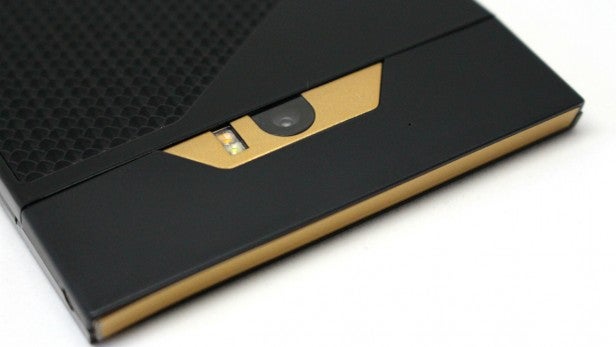
Each will have a slightly different texture on the rear panel, making the designs unique from one another. This particular Dark Wyvern model mixes gold and black to good effect, creating a device that looks like a premium proposition.
While it might not be to everyone’s tastes, I have to admit I’ve fallen a little in love with the unique aesthetics of this device, partly because I’ve been craving a handset that looks a little different after years of “me too” designs from the likes of HTC, Samsung and Apple – and this certainly looks different.
On the left-hand side of the Turing Phone you’ll find a fingerprint scanner, which also acts as a screen lock and home button of sorts. However, Sailfish doesn’t currently support such tech and Turing is hard at work creating its own workaround – a regrettable consequence of switching your OS towards the end of production.
Along the bottom edge sits a mono speaker and Wallaby MagStream port – the latter being a magnetic connection for charging and data transfer. Turing claims this choice of connection is based on security, as is the complete absence of a 3.5mm audio socket. Just like the iPhone 7.
Such ports make the device vulnerable to hackers, according to the manufacturer, and this means that out of the box there’s no current means of listening to audio via headphones. Turing is working on its own Bluetooth headset, which will be mailed out to buyers as soon as possible and sold with the final production model later this year – but if you have your own pair of wireless cans then they should work just fine.
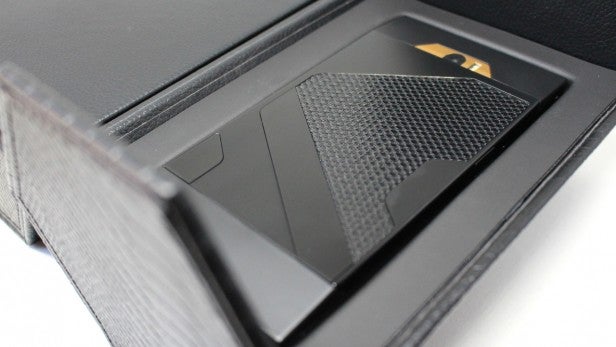
The Turing Phone’s 5.5-inch screen has a Full HD resolution of 1,920 x 1,080 pixels and is sharp enough for my liking. While Samsung and other handset makers continue to push displays with higher pixel counts, they strike me as largely pointless.
After all, if it’s impossible to make out individual pixels on a 1080p screen, why bother adding more when the only noticeable effect is likely to be an increased load on the processor? 1080p is perfectly fine for a screen of this size – and the other good news is that Turing’s device is equipped with a decent panel that boasts good colour depth, brightness and contrast.
When the Turing Phone was announced back in mid-2015, the fact that it was powered by Qualcomm’s Snapdragon 801 turned a few heads; the processor had already been surpassed in terms of power at that time. Fast forward a year and it’s positively archaic. But the good news is that the final version of the phone will have the more up-to-date Snapdragon 820. Also, 3GB of RAM is included – an entry-level amount for most flagships these days – while all evaluation units come with 128GB of internal storage.
Performance-wise, the Snapdragon 801 is really beginning to show its age. While the Turing Phone is nippy enough when it comes to everyday activities such as texting, web browsing and general navigation, it struggles with more intense tasks such as 3D gaming. I also noticed that the built-in email client stuttered frequently when browsing through my Google Mail account.
It’s worth noting that the software is still being optimised at present and there’s every chance that a future OTA will clear up some of these niggles – and it’s obvious that the introduction of the newer Snapdragon chip will boost overall performance.
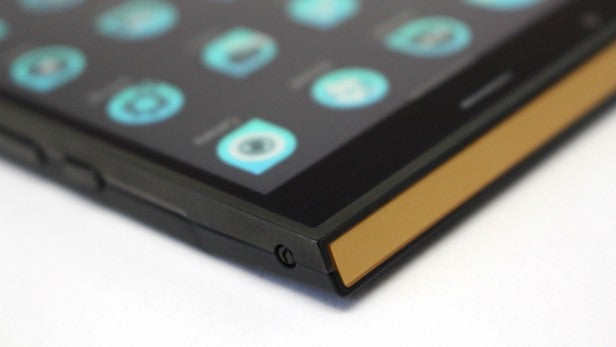
Given Android’s security weaknesses it’s understandable that Turing would seek an alternative OS for its devices, and Sailfish is perhaps the only genuine option out there right now. Since it’s based on Linux, it can run Android apps with no discernable performance issues, and the phone even comes pre-loaded with an app store that offers thousands of free-to-download Android apps.
It’s a good job, because at the time of writing, Sailfish’s own download repository is criminally low on content, lacking official apps for many of the big social networks and web services.
Being able to use Android apps is a real boon, but it comes with some provisos. Those that rely on the Google Play Services framework – such as Gmail and other associated Google downloads – won’t run properly on the Turing Phone at the time of writing. An OTA fix is apparently in the works to solve this problem, and should make the phone more appealing for those who rely heavily on Google’s suite of apps and services – which, let’s admit it, is the majority of smartphone users.
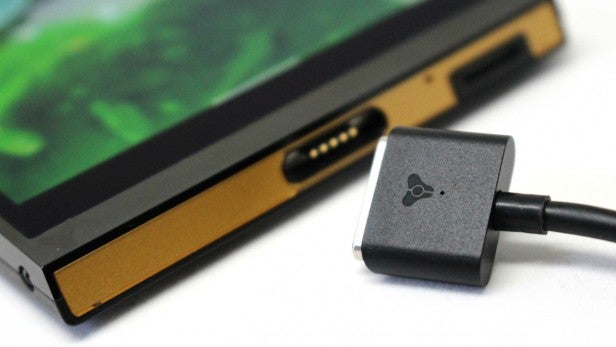
Sailfish itself is an interesting OS for those who have spent much of the past decade using an iPhone or Android device. Built from the smoking remains of Nokia’s abandoned MeeGo, it focuses on gestures for navigation rather than using the traditional “Home”, “Back” and “Menu” arrangement popularised by Google’s software.
For example, any app can be paused by swiping from the side of the screen, an action that brings up a menu showing your current active applications. Swiping from the bottom of the display opens the app drawer, while swiping from left to right shows your current notifications. When you’re in an app, gently swiping downwards opens a pulley menu at the top of the screen with a list of relevant options – this is also present in the dialler, with calls being accepted and rejected with an downward and upwards swipe respectively.
The beauty of this system is that you can move around the UI quickly using just a single finger, and navigating between open apps is pretty speedy since they’re never more than a right-to-left swipe away at any time.
Sailfish boasts support for Google accounts too, so linking the phone with your contacts and email is relatively straightforward. You can also link your Facebook and Twitter accounts so that notifications for these appear in the native UI. Sailfish shows promise, but ultimately, it lacks the flexibility and mature feature sets of iOS and Android – which is hardly surprising, as both of those have had a significant head start.
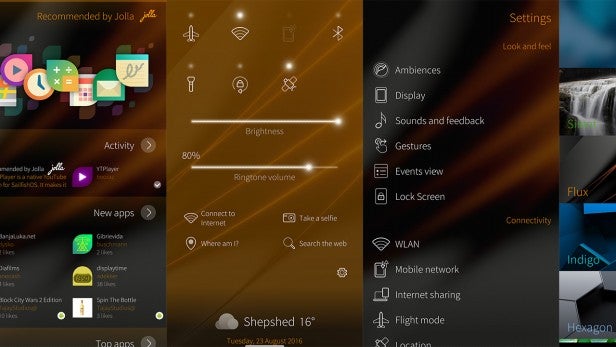
The Turing Phone’s UI won’t look like this for long, however. As was the intention when the phone pitched as running Android, Turing intends to layer its own user interface skin over the top of Jolla’s software.
Little is known about the promised “Turing Æmæth UI” at present, but it will undoubtedly unlock the encryption capabilities of the device that will allow Turing users to communicate with one another securely, thanks to robust end-to-end encryption – another key selling point of the phone back at its 2015 reveal.
In terms of photography, the Turing Phone comes equipped with a 13-megapixel rear-facing camera and 8-megapixel front-facing snapper. The main rear-facing camera produces detailed shots, and HDR support is apparently included but not enabled in this version of Sailfish. The camera is a little sluggish to boot up but that will presumably change once Turing has layered on its own UI improvements and enhancements. Video capture is also encouraging, with HD recording offering smooth and detail-rich footage.
The Turing Phone is offered in three storage options – 16GB, 64GB and 128GB. A microSD memory card slot is present on the SIM card tray so you can add more storage if you wish. Like all other evaluation units, my phone has 128GB of storage – more than enough for all my downloads, photos, videos and music.
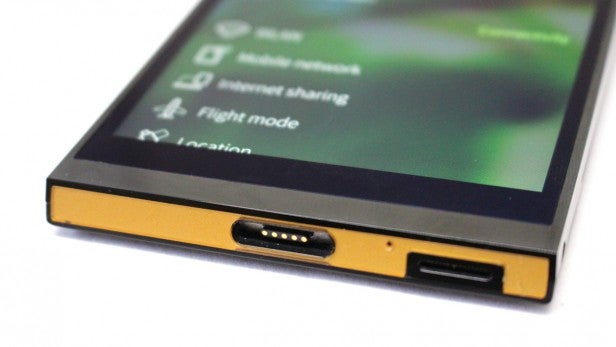
A 3,000mAh battery is featured, and due to the sealed nature of the phone, it can’t be replaced by the end user. Battery life is a difficult one to judge at this moment in time, since the software is still being tinkered with. However, it falls roughly in line with what you’d expect from your typical big-screen smartphone in 2016.
The Snapdragon 801 lacks the power-saving enhancements seen in the 820, making it even harder to get an accurate idea of the Turing Phone’s stamina, and Turing’s ongoing software optimisations will presumably yield superior staying power.
First Impressions
What Turing has done with this phone is totally unique; it has effectively mailed out pre-production test units to its customers ahead of giving them the (much delayed) end result.
The company’s critics will no doubt claim this is Turing’s way of keeping its customers happy while they wait for the final device – which will be a year overdue by the close of 2016 – but it effectively means that buyers are getting two devices for the price of one. It also means that users will be able to contribute meaningfully to the continued development of the concept by submitting bug reports and feedback, so the final product can be as polished as possible.
That’s why I’ve stopped short of giving the Turing Phone a review score here, because it clearly isn’t the final product – nor will it be available in stores in this “evaluation” form. For that reason, it would be unfair to review the device as-is. However, I’ll be revisiting it towards the end of the year, when the “final” Snapdragon 820 version arrives, complete with water-resistant coating, Bluetooth headset, Turing Æmæth UI and its much-hyped security features in place.
On a purely physical level, the Turing Phone really impresses. It looks stunning, feels reassuringly substantial and is fashioned from cutting-edge materials – and while those sharp corners look positively vicious in photos, they’ve not presented a genuine ergonomic issue for me so far.
Digging deeper into the device it’s clear that Turing has some work to do before we can really consider this to be the finished article. For the time being, the Turing Phone remains something of an enigma – one that has the potential to change the way we view security on our smartphones, and alter your perception of the way a device such as this should look.
How we test phones
We test every mobile phone we review thoroughly. We use industry standard tests to compare features properly and we use the phone as our main device over the review period. We’ll always tell you what we find and we never, ever, accept money to review a product.

